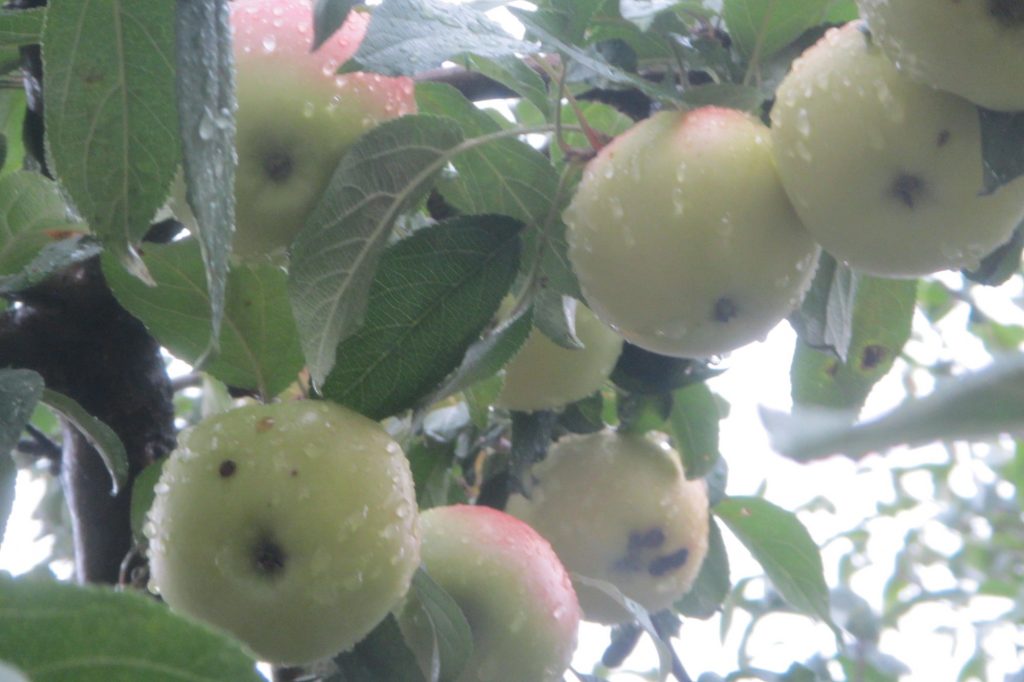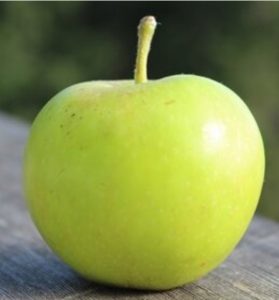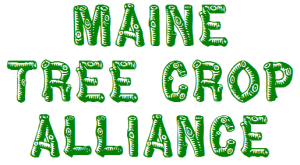Almost all named varieties of apple and crab apple seedlings are grafted, with a named variety grafted on top of a rootstock variety known for various beneficial characteristics. These characteristics might be drought resistance, dwarfing or semi-dwarfing of the tree, cold hardiness, and so forth. A “rootstock blowout” can happen when the top of a grafted union dies, but the grafted-upon root does not. The rootstock then sprouts and grows into a tree itself. Mostly, however, there is cohabitation, with remnants of the original grafted tree alive and in plain sight, although usually it is overtaken in size by the robustness of the rootstock. Often this is what happens in municipal landscape plantings where named varieties are planted for ornamental purposes, and then may be uncared for, perhaps for decades.
Below is an example of a rootstock blowout from a crab in Waterville. People have suggested that it might be an Antonovka seedling which as a variety is an ok edible. While I don’t have a good count on these rootstock “finds”, they seem abundant enough, especially with the neglect that seems to happen after the specimen trees are planted out.

Crabapple rootstock blowout discovered by Jack Kertesz near the Waterville Post Office and believed to be Antonovka.
Here is more info about the Antonovka apple from Salt Spring Apple Company in British Columbia including a photo of a known Antonovka apple.
This is the classic Russian apple, a couple of centuries old, yet still revered as much as ever by Russians at home and all over the world.
The epitome of multi-purpose, Antonovka is a tart fresh eating apple when it’s first ripe, a more complex eating apple given a bit of time in storage and a popular baking apple throughout.
Plus, most exciting for some of us, the root of this variety – when grown from seed – is a popular winter-hardy rootstock for grafting full-sized apple trees with an amazingly deep taproot. It is, therefore, both remarkably stable and drought-tolerant. Huge bonus for growers in a region like ours, where growing season irrigation water is oh-so precious.
On top of all that, Antonovka also happens to be a rare apple variety indeed: it grows very close to true from seed, which means a planted seed from an Antonovka apple will almost always produce a tree very similar to its mother, not a radically different, unpredictable hybrid. Which is what you get when you plant a seed of virtually every other apple variety in existence.
Other finds of mine have been offspring of varieties that have less of a possibility of coming true from the parent, (possibly Red Delicious), which is a reason to celebrate a “new” find.
[Added 15-Feb-2023]
I tried to think of alternative terms for “rootstock blowouts”. Not sure everyone would understand these, but it’s an opportunity to maybe inject some humor.
CRABrootstocks, Crootstocks, Crootstocksurprise
The list below contains farcical, unnatural hybrids of Malus domestica, or common apple, the understock or rootstock commonly used to produce flowering crabs found throughout much of our continental landscapes. They can make an appearance from neglect, or injury, and can lead to trees with dual personalities, with limbs with larger fruit than the grafted crab. I have found a number of these bearing remarkably clean and tasty fruit. Based on my observations, I can expect to find more.
Malus amesstica
Malus mistakica
Malus surprisica
Malus whatamesstica
Malus messeduptica
Malus pickmeinsteadica
Malus justbecauseicanica
Malus youshouldtakebettercareofgraftica


